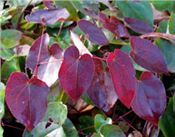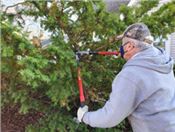Gardening Page
Versatile, Varied, And Shade-Loving Epimedium

Mass plantings of Epimedium ‘Amber Queen’ and ‘Pink Champagne’ offer pleasing leaf forms and soft contrasts of color.
Photo by Jason Reeves, courtesy UTIA.
Submitted by Troy B. Marden, host of Nashville Public Television’s Volunteer Gardener.
Bishop’s hat and fairy wings are charming common names for Epimedium and if you look at the flowers and newly unfurling leaves in early spring, it is clear how they came by them. As the tiny, wing-like leaves emerge from underground rhizomes in March and April, they are accompanied by clusters of delicate, dangling flowers which, with a bit of imagination, could be reminiscent of certain ecclesiastical headwear.
Over the past two decades, Epimedium have become increasingly popular with gardeners for their tough constitution and long season of interest in the shade garden. New selections and cultivars from enterprising plant explorers and hybridizers have expanded the offerings from just a handful twenty years ago to a smorgasbord of enticing leaf forms and flower colors that offer nearly year-round beauty. Among the many species — more than 60 at present count — the foliage can range from tiny and delicate (hence, the common name fairy wings) with soft, eyelash-like edges to long, leathery and sharply spined architectural forms. In many selections, new leaves emerge painted in red, copper or pink shades and in those that remain partly to completely evergreen, may take on tones of red to deep maroon-purple in winter.
The flowers are equally diverse, appearing from very early spring to early summer in a veritable rainbow of colors, including white to red, pink, yellow, orange, copper and deep, dusky purples. Often, they are bicolored, with the outer sepals being one color and the longer, sometimes “spidery” inner petals a contrasting shade, and they can range in size from the tiny, quarter-inch white stars of E. stellulatum to the dangling, two-inch yellow “spiders” of E. ‘The Giant.’ Plants can range in size from just a few inches tall to nearly two feet and in habit from strictly clumping, with little to no spreading, to slowly spreading groundcovers that will eventually form nice stands in and around other shade-loving plants.
Epimedium are best suited to bright, dappled shade in an open woodland garden where they will put on their greatest display, but have proven quite adaptable in locations ranging from morning sun to fairly deep shade. Once established, they are drought tolerant and deer are largely uninterested in their tough and unpalatable leaves. For maintenance, all that really is needed is a quick tidying up of old foliage in February, before flowers and new leaves begin emerging in March and April.
Of the many varieties now on the market, a few have been standouts in my own garden and gardens I have visited. At the top of my personal list is ‘Domino,’ a vigorous clump former that bears clouds of creamy white flowers tipped in deep rose from early spring to early summer. It is one of the longest-blooming varieties available. Also outstanding are ‘Amber Queen,’ ‘Pink Champagne,’ ‘Caramel’ and the species E. membranaceum with its large, yellow spring blooms and ruby red winter leaf color.
If you garden in shade, give these tough, adaptable, deer-resistant plants a try. You’ll be glad you did!
A variety of Epimedium species and cultivars can be found at the UT Gardens, Jackson, and Knoxville.
The UT Gardens includes plant collections located in Knoxville, Crossville and Jackson. Designated as the official botanical garden for the State of Tennessee, the collections are part of the UT Institute of Agriculture. The Gardens’ mission is to foster appreciation, education and stewardship of plants through garden displays, educational programs and research trials. The Gardens are open during all seasons and free to the public. For more information, see the Gardens website: utia.tennessee.edu/state-botanical-garden. ∆
Trim Trees, Shrubs In The Dormant Season For Stronger, Healthier Plants

Pruning a yew.
Photo by Sarah Vogel
SARAH VOGEL
URBANA, ILLINOIS
Throughout the growing season, gardeners and arborists talk about the benefits of pruning woody ornamentals while they are dormant, and that time is almost here.
“Pruning can seem like a daunting task, but it is an important cultural practice for the health and vigor of many trees and shrubs,” says University of Illinois Extension Horticulture Educator Sarah Vogel.
Pruning is done to reduce the size and shape of the plant, increase flower or fruit production, and promote sound structure.
The correct time to prune deciduous shrubs and trees is determined by the plant’s growth habit, bloom time, and health or condition. Timing will depend on the species, but any time is a good time to remove dead, dying, or broken branches. Be sure to sanitize tools between plants with a 10 percent bleach solution or undiluted 70 percent isopropyl alcohol. Sanitize between each cut if a disease is suspected.
Spring flowering shrubs, such as lilac or forsythia, will bloom on the growth from the previous last growing season, sometimes called "old wood". The best time to prune a healthy plant is immediately after flowering in spring. Overgrown shrubs may need more extensive pruning through rejuvenation or renewal methods in late winter or early spring. Heavy pruning methods may lead to fewer blooms for a few years but will improve the overall health of the shrub.
Summer blooming shrubs, or those that bloom after July 1, produce blooms on the current year’s growth. These are best pruned in late winter or early spring.
“Do not prune deciduous shrubs in late summer as that will encourage a flush of new growth that will not have the opportunity to harden off before winter, leaving the plant susceptible to frost damage and dieback,” Vogel says.
Many of the same rules for shrubs also apply to deciduous trees. Most will respond well to late winter pruning, including fruit trees.
Performing this task on trees in the dormant season gives the pruner an increased visibility of the tree’s shape without any leaves and enough time for proper wound closure for the plant. When branches are cut correctly at a node or at the branch collar, the plant will seal wounds properly to prevent the spread of decay and entry for potential pests and pathogens.
There are some exceptions to early spring pruning. To reduce the spread of oak wilt disease, oaks should not be pruned from March through October. River birch will respond best to cuts made in late fall or early winter after leaves have fallen and when sap flow is reduced.
Pruning techniques on evergreens will vary depending on the species and desired effect. Fall pruning is not recommended for evergreens, as any new growth will be susceptible to winter injury. Evergreen shrubs such as juniper and yew can be pruned in March or April before new growth emerges. Evergreen trees such as pine, spruce, and fir generally require very little pruning, and removing lower branches is not advisable as it compromises the structural integrity of the tree.
Spruce and fir trees have lateral buds on the newest growth. These are buds that grow from the sides of the branch, not the ends. To create a more dense form, prune back to these lateral buds in early spring.
Pines only grow from terminal buds at the end of the branch. Pines are prunes are pruned in spring or early summer at the candle stage by removing two-thirds of the elongated bud. Do not cut branches back to older growth as they will not develop new growth from those areas.
Relieve the winter blues by choosing the next calm, sunny, 40-degree day to put on boots and get some sunshine. The improved health of your trees and shrubs will be worth it. ∆
SARAH VOGEL: Horticulture Educator, University of Illinois